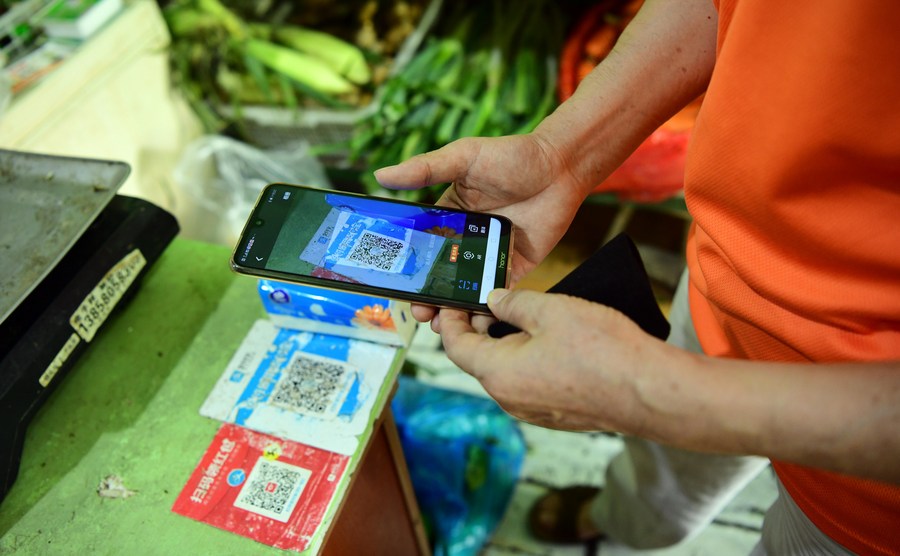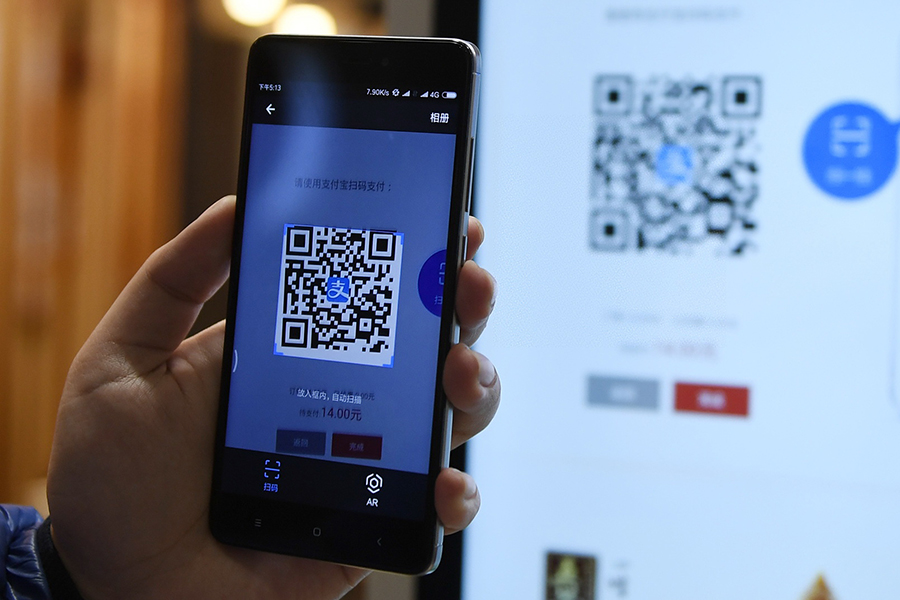A smartphone is all you need to enjoy a proper trip in Lhasa, the Xizang Autonomous Region, known as “the roof of the world.”
A QR code is all you need to access transportation in the fast developing Guangdong-Hong Kong-Macao Greater Bay Area.
Buying subway and bus tickets by mobile phone, paying electricity bills at home, getting duty refunds by scanning a QR code at the airport… these convenient scenarios have become daily routines for people in China.

A person pays at a vegetable stall in Hangzhou, capital of east China's Zhejiang Province. (File photo: Xinhua)
With a more than 95 percent personal bank account ownership rate that is higher than the averages for mid- and high-income economies, China's mobile payment penetration has reached 86 percent, ranking the first in the world, according to the People's Bank of China. These figures indicate that be it in cities or in rural areas, China, a populous country, has enabled its people to enjoy convenient and fast modern financial services.
Payment is an important component of economic activities. Becoming the world’s No.1 in terms of mobile payment penetration is not only an achievement of the financial industry, but also an embodiment of the country’s overall technological strength and the vitality of its economy.
The path to the "world's No.1" is one that started from scratch and brought the country from weakness to strength.
From food coupons to banknotes, from bank cards to mobile payments, the shift of payment methods in China marks the country’s economic prosperity and technological progress and is also a miniature of shifts in lifestyle and business modes.
Not long after the reform and opening-up policy came into effect in 1978, foreign payment methods such as debit cards and credit cards changed Chinese people’s lives significantly after they were introduced into China, starting from coastal areas such as Guangdong Province to the inland. Nowadays, Chinese payment methods such as WeChat Pay, Alipay, Cloud Quickpass are leading global payment trends. From an importer to an exporter of technology, China has proven its constantly deepening high-standard opening-up and showcased its quality of economic development and overall strength that is not what it used to be.

A consumer pays with Alipay after ordering food at the first self-service restaurant in Hangzhou, Zhejiang province. (File photo: Xinhua)
Now mobile payments are a new business card for China’s high-quality development. More than 90 percent of adults in Kenya use mobile payment services supported by Chinese technology. In Finland’s famous Nordic tourist destination Rovaniemi, Alipay is available in many businesses. China UnionPay’s Cloud Quickpass has opened services in 95 countries and regions around the world. With tested technology and the ability to implement services, Chinese standards in the global mobile payment domain have become “golden standards.”
This “world’s No.1” is a comprehensive reflection of China’s economic strength and development vitality.
On the surface, the change from cash to mobile phones seems like only a change in the ways of payment, but behind it is a series of innovations of complicated technologies and the support of an industrial foundation.
Behind the “world’s No.1,” there is the biggest communication network in the world. Mobile payments are inseparable from support from a mobile network that is high-speed, reliable and has wide-coverage. China has built the world's largest and technologically leading 5G network. In the vast land of China, the 5G network covers urban areas of all prefecture-level cities and counties and more than 99 percent of administrative villages having been connected to fiber optic networks and 4G networks.
Behind the “world’s No.1,” there is the largest group of mobile phone users in the world. Mobile payments require advanced communication equipment of both parties involved in a deal. From 1988 to 2018, China's mobile phone users have grown by 520,000 times. By the end of 2022, the number of mobile phone users in China reached 1.683 billion, of which 5G mobile phone users amounted to 561 million, 2.75 times the global average.
Behind the “world’s No.1,” there is an energetic Chinese market. Consumer demand is intrinsic to the development of the payment industry. From January to November 2023, China's online retail sales of physical commodities increased by 8.3 percent year-on-year, accounting for 27.5 percent of total retail sales of consumer goods. China’s vibrant and thriving market created a perfect environment for the rapid growth of mobile payments.
The “world’s No.1” will enable deep-level transformation of the digital economy.
The development path that mobile payments have traveled is a road of innovation where demand pulls supply and supply creates demand. The payment pain points call for technological innovation, and in turn, the huge changes in payment methods have opened up a bigger market space, which has then fostered the world's largest online retail market.
Today, the rapid development of the digital economy has not only put forward higher requirements for mobile payment, but also brought about greater development space. As an important part of digital infrastructure, mobile payment can penetrate into the value chain of the digital economy and play a fundamental role in interoperability, integration and benign symbiosis, thus accelerating the digital transformation of the entire economic system.
Mobile payments are energetic, and the future of digital China is promising. At present, mobile payments are deeply integrated with various industries such as clothing, food, transportation, housing, subsistence expenses, investment and financial management, healthcare, educational training, constantly catalyzing new businesses and economic growth points and continually injecting inexhaustible momentum into China's economic and social development.
(Compiled by Fu Junjie and Qiao Wai)


